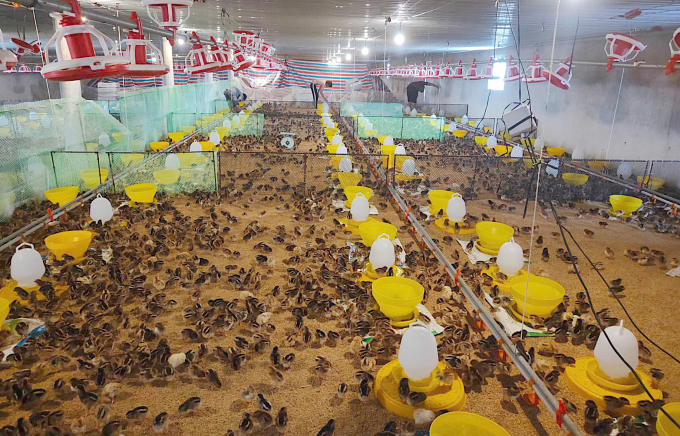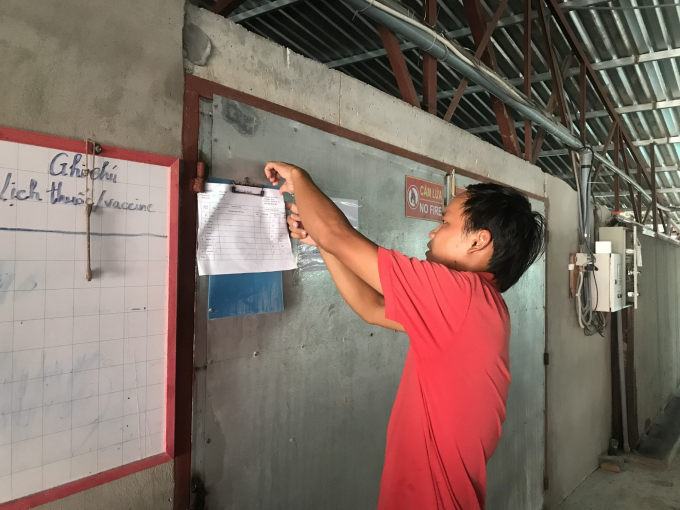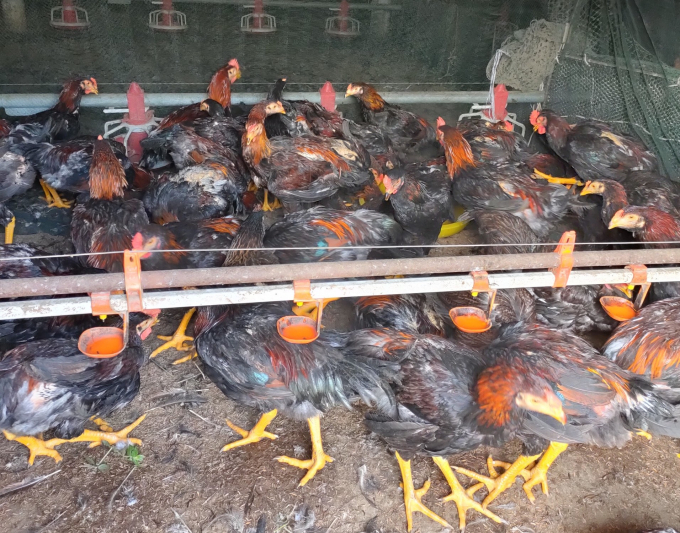June 21, 2025 | 02:11 GMT +7
June 21, 2025 | 02:11 GMT +7
Hotline: 0913.378.918
June 21, 2025 | 02:11 GMT +7
Hotline: 0913.378.918

At the bio-security closed livestock farm, waste is treated well, which minimise negative impacts on the environment. Photo: Minh Dam.
According to the Department of Agriculture and Rural Development of Vinh Long province, in recent years, local livestock farms have approached and applied many advanced technique and processes from FDI enterprises.
In particular, the strict application of biosafety livestock production brought many positive results. Most biosecurity farms can safely stand against recent outbreaks. Biosecurity measures for livestock production play an important role in disease prevention and control and sustainable livestock development in Vinh Long Province.
Nam Nghia chicken breeding facility, in An Phuoc commune, Mang Thit district currently has three farms with an average size of 1-2ha/farm. The facility owner co-operated with CP Livestock Company Vietnam and another enterprise to raise commercial breed chickens.
Tran Phuoc Loc, owner of the facility, said that the farms applied closed disease-free technology. Their products are of high quality and are favoured by customers. The farms just finished exporting a batch of chicken to the Ho Chi Minh City. Loc asked staff to clean the chicken raising area and prepared for a new farming season.
Loc said that normally few people could enter or leave his farms. Employees working here are not allowed to interact with outsiders. Even Loc rarely goes anywhere. If outsiders want to enter the farming area, they must take a bath and rest for a few minutes before working.

Tran Phuoc Loc, owner of the chicken raising facility checks the vaccination schedule for chickens. Photo: Minh Dam.
“After harvesting a batch of chickens, I let the staff clean, disinfect, and lime the floor of the barn. When stocking a new batch, spread a lot of fresh rice husks to form a dry mattress so that the chicken's waste does not become moldy, causing bad odors to pollute the environment. In addition, it is important to carefully observe the chicken droppings after each night. If the chicken is sick, the feces will have a bad smell, so it must be treated immediately. Healthy chickens will limit the use of drugs. Products without antibiotic residues are welcomed much by customers.”
Loc said that for the biosafety model of raising chickens, each batch of chickens lasts three months. Each year, he stably raises three batches.

Trucks transporting food, commercial chickens from/to the farm are cleaned, disinfected with lime and antiseptic. Photo: Minh Dam.
According to the Department of Agriculture and Rural Development of Vinh Long province, to achieve high efficiency in disease prevention and control, in addition to vaccination, the synchronous implementation of biosafety technical solutions is very important.
The department instructed farming households to pay special attention to the following 5 measures:
First, isolation: There should be a necessary distance between livestock production facilities and residential areas, roads, livestock farms, breeding areas, food storage houses, and manure disposal areas.
Second, monitor hygiene and disinfection: At the entrance to the livestock area, it is necessary to arrange disinfection pits with lime powder or chemicals. For livestock farms, it is necessary to have changing rooms, disinfecting rooms and bathrooms for workers and people who enter/leave the livestock area. Food storage area must meet hygienic conditions, weekly be disinfected.
For barns, livestock equipment and tools must be cleaned daily and replaced with wet litter. Periodically clean and disinfect the breeding area with lime powder or disinfectant.

Biosecurity farms "stand firm" during disease outbreaks. Photo: Minh Dam.
Third, feed for livestock and poultry must be nutritionally adequate for each breed and each stage of rearing. Food must be stored in a dry, clean place, not be moldy, expired, contaminated, or toxic. The source of drinking water for livestock and poultry must be clean, hygienic and periodically checked.
Fourth, control access to livestock areas: Minimize people entering and leaving the farm, arrange for workers to eat and sleep at the farm (especially during times of high risk of outbreaks). Before entering the camp, they must bathe and change clothes (especially workers are not allowed to raise livestock and poultry in their own homes). Veterinarians of the camp are not allowed to practice outside the camp.
Cattle and poultry brought into the farm must be healthy and imported from a disease-free facility (with a full quarantine certificate). Newly purchased livestock and poultry before entering the herd must be isolated and monitored for at least three weeks. All livestock and poultry must be fully vaccinated and given preventive medicine on schedule.
Fifth, handling the occurance of a pandemic : When livestock and poultry die or die in mass, they must immediately notify the local government and veterinary staff for timely handling.
Do not sell sick livestock and poultry, do not throw livestock and poultry carcasses indiscriminately into ponds and lakes around the farm, do not eat meat of sick cattle and poultry.
Destroy dead cattle and poultry suspected of having dangerous diseases by burying and burning under the guidance of veterinary officials. Sanitize, disinfect, disinfect the barn and the environment around the outbreak with lime powder or chemicals. Vaccinate all livestock and poultry around the epidemic area.
Support VND10 billion to carry out disinfection and sterilisation
Le Thanh Tung, Director of Vinh Long Provincial Sub-Department of Livestock, Veterinary and Fisheries, said that the Sub-Department was developing plans to disseminate legal documents on biosafety livestock and supportive policies in the prevention of epidemics in livestock.
Currently, the unit also advises on building a plan to prevent animal diseases in 2022 with a budget of over VND10 billion. The plan focuses on the implementation of disinfection, environmental protection and prevention of infectious diseases such as rabies, avian influenza, livestock and poultry diseases, foot-and-mouth disease, and skin rash.
Translated by Hien Anh
![Turning wind and rain into action: [9] Digitizing hydrometeorological data in response to climate change](https://t.ex-cdn.com/nongnghiepmoitruong.vn/608w/files/news/2025/06/17/z6704423696987_15fd32ffc26d590d204d520c9dac6786-nongnghiep-165943.jpg)
(VAN) Farmers have begun accessing hydrometeorological applications to adjust their cropping schedules, aiming to ensure productivity and adapt to climate change.
![Turning wind and rain into action: [8] Real-time salinity detection and early warning technology](https://t.ex-cdn.com/nongnghiepmoitruong.vn/608w/files/news/2025/06/17/z6704423696987_15fd32ffc26d590d204d520c9dac6786-nongnghiep-151127.jpg)
(VAN) Thanks to the integration of modern hydrological-hydraulic models, remote sensing technologies, and artificial intelligence, the accuracy of hydrological forecasting has significantly improved.
![Turning wind and rain into action: [7] Early disaster warnings help marine farmers minimize losses](https://t.ex-cdn.com/nongnghiepmoitruong.vn/608w/files/news/2025/06/17/z6704423696987_15fd32ffc26d590d204d520c9dac6786-nongnghiep-142942.jpg)
(VAN) In recent years, thanks to early disaster warnings and forecasting, marine farmers in Khanh Hoa province have been able to reduce risks and losses, thereby improving production efficiency.
![Turning wind and rain into action: [6] ‘Four on-the-spot’ disaster management software](https://t.ex-cdn.com/nongnghiepmoitruong.vn/608w/files/news/2025/06/17/e5a48259d6a262fc3bb3-nongnghiep-183800.jpg)
(VAN) By simply activating the scenario on the disaster management software, the relevant authorities immediately know how many households need to be evacuated, where to evacuate them to, and by what means of transportation…
![Turning wind and rain into action: [5] Hue applies modern technology in disaster forecasting](https://t.ex-cdn.com/nongnghiepmoitruong.vn/608w/files/news/2025/06/17/z6704423696987_15fd32ffc26d590d204d520c9dac6786-nongnghiep-093938.jpg)
(VAN) In Hue city, modern technology has recently been applied in meteorological and hydrological forecasting and warning, helping to reduce the damage caused by natural disasters.

(VAN) A cutting-edge farming technique being implemented on an experimental ranch in Arizona's Sonoran Desert has already saved a billion gallons of water over five years, according to Civil Eats.

(VAN) Poultry and pig production and the environment can be boosted through enhanced water technology, according to new research.